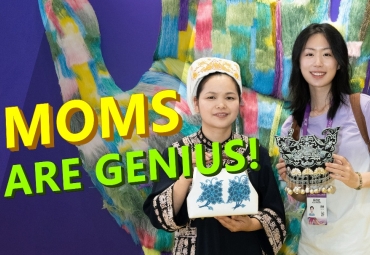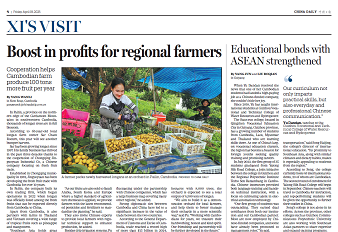A design for life

Wang Jing demonstrates weaving Bouyei costumes for children at her workshop in Xingyi, Guizhou.[Photo provided to China Daily]
Inheritor dedicates herself to innovating Bouyei ethnic costumes and their elements drawn from the natural world, to keep pace with the times, Yang Feiyue reports.
Blue turban, greenish-blue collarless lapel jacket, a pleated skirt and a pair of embroidered shoes with pointed toecaps — a Bouyei woman, with her distinctive traditional ethnic costume, is easy to spot.
Local ethnic women have carried forward the traditional art that bears the love of their mothers and was named a national intangible cultural heritage by the State Council in 2014.
They have also weaved in new elements to help the art keep pace with the times and appeal to the younger generation.
Wang Jing is one of them.
The woman from Xingyi city, the Qianxinan Bouyei and Miao autonomous prefecture of southwestern China's Guizhou province, has given up many lucrative opportunities, choosing to stay in her hometown and imbue the traditional ethnic clothing with an innovative spirit.
Wang, in her early 50s, had been snowed under with orders for ethnic clothes since the fourth quarter of last year, especially during the build-up to Spring Festival.
"Most of those traditional costumes were requested by locals who want to wear them for the holiday or other celebrations, like weddings," Wang says.
A considerable number of them were for travelers who will wear them and experience local folk customs, she adds.
In Wang's workshop in Xingyi, polychromatic clothes featuring various local ethnic elements abound.
"My business is about making ethnic costumes specific to Guizhou, but mainly the Bouyei ones," Wang says.
"We want people to learn about and understand the ethnic costumes and we want to pass on this craftsmanship."
Wang has made a point of injecting modern aesthetics into the traditional costume craft while retaining the vital traditional elements.
"I've made a few upgrades to the traditional cut," she says.
For instance, Wang has taken in the sleeves and waist areas to accentuate the curves of the female form. She also broke new ground by sewing on the waistband.
"This way, it saves the trouble of taking it on and off every time you need to change clothes," she explains.
Moreover, Wang has created more color combinations, which have proved popular with local ethnic women, especially those of the younger generation.
Such adjustments have made her costumes very popular across the province.
However, she has made sure the traditional patterns and main colors are not compromised.
"Generally speaking, flowers, birds, fish and insects are major totems on Bouyei costumes," Wang says, adding that they are things worshiped by Bouyei people, who protect the local ecology and care for the environment.
"They all originated from nature and have been artistically processed to evolve into the patterns we see today."
Ethnic costume styles vary with the local environment.
"For example, aquatic animals like fish and shrimp have emerged more in embroideries near the Nanpan River, while those originating in mountainous areas feature flowers, grasses, bamboo and banana leaves," Wang explains.
Born into a Bouyei family, Wang grew up wearing the traditional clothing, which was made by her grandmother and mother.
"I would sit on a small stool and watch the polychromatic threads traveling through their hands," she recalls.

Wang Jing.[Photo provided to China Daily]
"It was magic how the vivid patterns of various styles then slipped through their fingers." Wang started to learn how to make Bouyei clothes at 10 years old.
She came to appreciate the whole process, from yarn-dyed weaving to batiking, tie-dyeing, cross-stitching and brocading.
In particular, batiking and tie-dyeing are common coloring techniques. For batiks, Bouyei women can draw patterns on cloth directly with a wax knife, and then go through several processes, such as waxing, dyeing, dewaxing and cleaning before transforming plain cloth into brightly-colored fabric art.
As for tie-dyeing, the white cloth is ingeniously tied before being immersed into the dye, which does not reach the parts of cloth that are tied. These parts therefore retain their original color, and form the strongly contrasting pattern.
Stitching is frequently applied to make decorations on collars, cuffs, shoulders and skirts.
It takes anything from several days to several months to finish a costume, depending on the style and complexity of the patterns.
Wang's early exposure to the craft predisposed her to the costume details. She paid special attention to patterns on other people's clothes and would later try her hand replicating them on rags at home.
Whenever opportunity arose, Wang would engage in needlework with local women, making embroideries and sewing bags.
"It became part of my life," she says.
A turning point came when, after graduating from middle school, Wang found admission information for a Beijing-based costume research institute in the pages of a magazine at the local library.
It rekindled her passion to make a career out of the traditional clothing.
After saving enough money by doing odd sewing jobs, in 1991, Wang embarked on a journey to Beijing.
She spent time building up her knowledge of fine arts, while honing her sketching and costume design skills.
Two years later, Wang graduated with an intermediate costume designer certificate. As many of her classmates explored opportunities in better developed areas, such as Beijing and China's coastal cities, Wang insisted on coming back to Guizhou to apply what she had learned to the traditional clothing of her beloved community.
"I just felt like my roots were here," she says.

Young people in traditional Bouyei costumes.[Photo provided to China Daily]
Wang started off as a designer at a batik workshop in Guizhou's Anshun city, where she saw that international visitors showed a strong interest in ethnic clothes.
It spurred her on to further tap the potential of aboriginal costumes.
In her spare time, she trekked across the province, visiting Bouyei villages spread far and wide in search of original costumes and manufacturing techniques.
"During my research, I found the ancient treasures were slowly disappearing," she says.
"Some century-old embroidery skills that require 100-percent handwork were nearly lost, and I feel obligated to protect and pass on these national cultural treasures."
Therefore, she made up her mind to return to her hometown of Xingyi to promote and inherit the traditional art.
Wang attributed the lackluster development of ethnic costumes to uneven production quality, monotonous style and lack of design.
Her previous learning and expertise had made her sharply aware that upgrading the costume design and standardizing production quality was the only way to revive the craft.
In 2001, an opportunity for Wang to demonstrate her skill arose when local authorities staged a rafting festival in Xingyi.
Wang immediately approached the organizers and bid for the task of making the ethnic costumes for tour guides and rafting participants. She won the organizers over after presenting her meticulous designs.
Two weeks later, a batch of costumes displaying fine workmanship, novel styles and unique ethnic characteristics were delivered and became a highlight of the event.
This initial success encouraged Wang to start her own ethnic clothing business in 2002.
She has since encouraged local women to join her and offered them training.
"I was thrilled to see many women still keep the tradition of weaving cloths and batiking," Wang says, recalling her research visits to the villages.
She considered it valuable and felt it imperative to bring the techniques to the public eye.
Wang invited the rural embroiderers to her workshop and taught them advanced ethnic costume craftsmanship. Afterward, they were able to make costumes from home.
To date, she has given training to 9,000 local embroiderers, including more than 1,000 Bouyei women, across the Qianxinan Bouyei and Miao autonomous prefecture.
Whenever she encountered a problem during her research, Wang would waste no time in trying to address it. For instance, when locals were concerned about the color fade of plant-based dyes, she found science institutes to tackle the issue.
Wang would also purchase ethnic handicrafts from villagers to reinforce their confidence in the traditional art.
At the same time, Wang has continued to collect and collate Bouyei costumes through field trips.
"I stumbled upon some costumes that are more than 100 years old," Wang says.
"The owners didn't wear them any more and readily gave them to me, and I would send them some gifts in return," she adds.
In 2016, Wang set up a Bouyei costume museum which displays more than 400 intangible cultural heritage items, mainly related to costumes that she has collected over the past two decades.
The museum has since received many students from institutes of higher learning, including Peking University, Tsinghua University, and the University of Hong Kong. More than 10,000 international visitors, including those from South Africa and Nepal, have knocked on her door to savor the region's distinctive costume culture.
Wang's ethnic costumes, with their innovative elements, have also made their way overseas, including to the United Kingdom, Russia and Singapore.
Currently, major Bouyei costume making elements are spread across 11 cities, counties and districts in Guizhou, according to Shi Jingyi, an official from the Guizhou culture and tourism department.
Local authorities will set up Bouyei costume research facilities in the province's southern, central and western areas. Related intangible cultural heritage workshops and production sites will also be established.
"Only if we ensure the authenticity, integrity and inheritance of the intangible cultural heritage, can it survive and thrive," says Long Youming, director of the provincial intangible cultural heritage protection center.
Long believes that ethnic costumes will play a positive role in Guizhou's tourism development and empower local culture and rural vitalization.
As Guizhou's infrastructure and tourism improved, Wang has noticed how cultural products with local ethnic characteristics are increasingly sought after.
"I will strive to enable Qianxinan Bouyei costume to find a global audience, through the integration of ethnic and ecological culture with fashionable elements to develop new products," Wang says.
All rights Reserved. 京ICP备13028878号-8







 Overview
Overview Guiyang
Guiyang Guian New Area
Guian New Area Liupanshui
Liupanshui Anshun
Anshun Qianxinan
Qianxinan Qiandongnan
Qiandongnan Qiannan
Qiannan Zunyi
Zunyi Tongren
Tongren Bijie
Bijie Guizhou commits to culture preservation and rural vitalization
Guizhou commits to culture preservation and rural vitalization Guizhou voice at 2025 national two sessions
Guizhou voice at 2025 national two sessions Meet the 'genius moms' at Shenzhen cultural fair
Meet the 'genius moms' at Shenzhen cultural fair 

